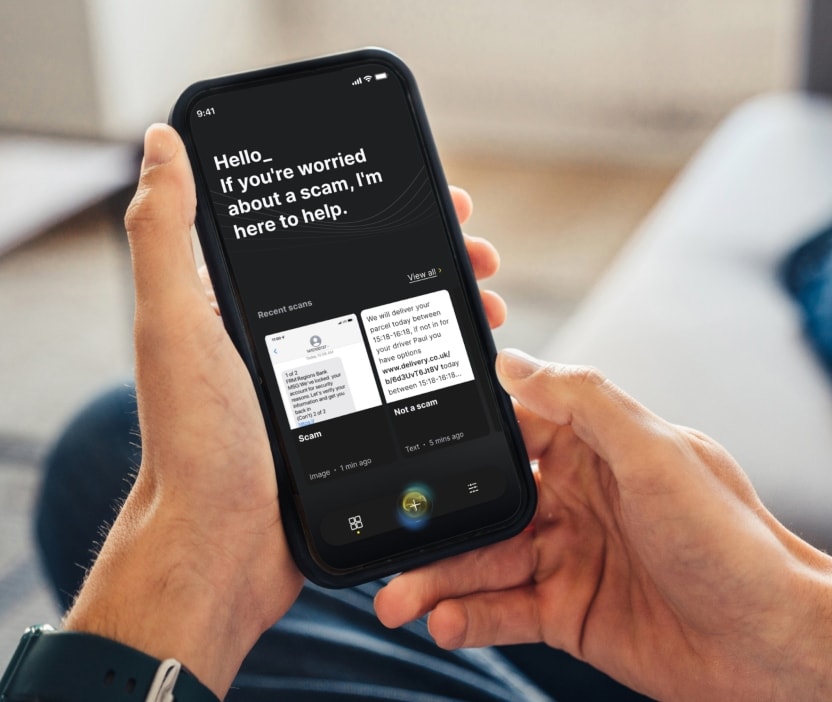Is that message a scam? Ask the AI behind Genie

In our digital lives, cyber threats evolve quickly. Norton is taking a groundbreaking leap with Genie, our latest innovation in scam detection and cybersecurity.
It could happen to you while you’re out at dinner. It might happen on the couch as you’re enjoying a book. It could even happen during your vacation in a faraway place. You get a text message, a DM, or an email that looks and feels real, but you’re just not quite sure you should click on that link.
Is that a real alert from your bank? Has your account really been compromised? It would be ideal to have a friend who’s an expert on scams to look over your shoulder. They could instantly tell you if your suspicions are correct or if you don’t need to worry. We have a similar option.
Norton Genie, utilizing advanced proprietary artificial intelligence (AI), instantly reveals what you need to know about suspicious messages, so you can relax and get back to your meal, your book, or your vacation.
Introducing Norton Genie
Genie is a new AI-powered security tool from Norton that helps protect people from scam messages they receive through email, social media, and text messaging.
There are more than 6 billion smartphones in the world, not to mention laptops, tablets, and other digitally connected devices. All these devices are potential targets for attacks from scammers, and while attacks on systems and software are dangerous, equally as dangerous are attacks on human cognition.
Hackers and scammers are pairing social engineering with generative AI to manipulate our emotions, knowledge, and intentions. Genie is made to help detect and defeat these tactics.
An AI solution designed to work with real-world problems
The inspiration behind Genie stemmed from the understanding that cyberattackers have shifted their focus from infiltrating software exploits to exploiting people.
“In the last years, at Norton, we’ve observed a decline in attacks on devices and a simultaneous rise in attacks designed to manipulate human decision-making. More precisely, these attacks became psychological rather than technological, requiring a new line of defense,” Gen Chief Technology Officer Michal Pěchouček shares. “We had to ask ourselves: how can we create an app that objectively and reliably helps a person defend against a psychological attack through a message?”
To help detect these attacks, Genie starts with a screenshot. For Genie’s AI to begin to analyze whether a message is a scam or not, and for a user to easily share that information with Genie’s AI, all that’s needed is a screenshot of the message in question.
For any smartphone user, taking a screenshot is a familiar, straightforward process. For Genie, it’s the most reliable method of capturing the context of any message and discerning the legitimacy of emails, social media posts, and messages.
How AI systems power Genie
“We knew early on that AI would be central to Genie,” Mr. Pěchouček continues. “Cybersecurity has inherently become a domain of AI, with both attackers and defenders relying heavily on emerging generative tools. Genie harnesses a blend of two distinct systems.”
The first system is Norton’s proprietary AI, which focuses on text analytics and perpetual training to detect scams. That AI is informed and trained by decades of data collected by Gen. In addition, this AI is constantly learning and evolving to detect new scams.
Second is an advanced conversational AI that enables the app and the user to communicate fluidly and naturally. The app and the user can ask each other questions in a natural way.
The combination of this AI is unprecedented in the cybersecurity world. Genie doesn't just test for scams; it's an ever-learning expert in your pocket, trained to discern the nuances of interactions and intentions from any message you receive.
How Genie understands the difference between a scam and a legitimate message
“AI can often produce false positives or hallucinations,” Mr. Pěchouček says. “It would be very simple to create an AI that attempts to detect a scam which, when there is uncertainty, it calls the message a scam by default.”
To understand this idea more easily, think about creating an AI that can find a dog in a picture. You might start by training the AI to tell the difference between a dog and anything that is not a dog. Further, you tell the AI that if it finds something that might be a dog, but isn’t certain, it’s safer to say it’s a dog. In this scenario, the AI will generate false positives.
A picture of a Labrador could be identified as a dog. A picture of a fire hydrant could be identified as a not a dog. But, a picture of a cow, a lion, or a sheep could mistakenly all be called dogs if the AI doesn’t understand the data. It hasn’t been trained properly.
To make Genie reliable and trustworthy, its AI doesn’t attempt to train solely on messages that are scams, but also messages that are legitimate. To borrow from the example above, it isn’t focused only on dogs, it also learns about cats, cows, and sheep.
Creating an AI that can learn to identify a legitimate message equally as effectively as a scam message is a challenge. The difficulty lies in defining what constitutes a legitimate message, which is inherently more complex and difficult to define than a scam message.
Think about it: Most people can instantly define why an email from a Nigerian prince promising a fortune is a scam. That scam is usually riddled with grammatical mistakes, offers the reader easy money, and proposes the exchange of sensitive information. Alternatively, how can you define that an email from an online store that you’ve done business with isn’t a scam? It tries to make an emotional connection, promises savings, and wants you to click on a link.
Human power behind AI training
Genie learns from the screenshots that users share to constantly improve its awareness of scams and legitimate messages. It also learns from humans—from its users' interactions, security experts behind the scenes, and the ability to adapt to various geographical and cultural contexts. This ongoing training ensures that Genie remains effective against localized scams and user-specific queries.
The human factor behind scam detection is critical, and it creates a model of how AI and people work side-by-side. The AI takes on the tasks that humans cannot accomplish–instantly analyzing and responding to millions of messages per day. The human power—our worldwide team of security experts—takes over when AI develops uncertainties, in order to keep the AI from engaging in guess work.
This combination of human and AI effort, dedicated to the accuracy and security of users, underpins everything Genie does.
How Genie learns about new scams
Genie’s AI continually refines its understanding of scams and legitimate messages. Its learning process is dynamic, and it’s improved and updated constantly. Those improvements come from data, both from its users, as well as new data discovered and added by the security engineers behind the scenes. In some cases, this becomes “training data,” or data that is used to help train the AI to be smarter.
Genie is powered by a wealth of experts and engineers who understand security better than anyone else. Those experts label the training data, teaching Genie how to resolve uncertainties, and constantly feed updated information back to the AI so that it can adapt to emerging threats.
This combination is critical when a new scam emerges.
For that case, Genie doesn’t just rely on known patterns. It analyzes the contextual elements of the message and asks questions–the same kinds of questions humans should ask:
- Is the message creating a sense of urgency?
- Is the message making a request for money?
- Is it demanding personal information to confirm something?
- Does it link to a website that isn’t secure?
Genie considers these questions (and quite a bit more). The comprehensive analysis allows Genie to provide timely warnings to users, even for previously unseen scams.
Over time, Genie only gets better and grows in its ability to distinguish scams and patterns.
This expansion will allow users to seek advice on a wide range of cybersecurity topics while also helping them develop their own awareness about scams and attacks from threat actors.
Where will we go from here?
Genie represents more than just a technological advancement; it's a tectonic shift in how people manage their personal cybersecurity and interact with AI. A key principle behind Genie is that it does not seek to replace human cognition. Rather, it leverages data to support humans to make better decisions for themselves and become smarter about security. This approach sets a new standard in the industry.
It’s not just about defending against threats; it’s about empowering users to make informed decisions and enhancing their digital independence and safety. With Genie, Norton is paving the way into a new era of AI-powered cybersecurity.
Editorial note: Our articles provide educational information for you. Our offerings may not cover or protect against every type of crime, fraud, or threat we write about. Our goal is to increase awareness about Cyber Safety. Please review complete Terms during enrollment or setup. Remember that no one can prevent all identity theft or cybercrime, and that LifeLock does not monitor all transactions at all businesses. The Norton and LifeLock brands are part of Gen Digital Inc.





Want more?
Follow us for all the latest news, tips and updates.